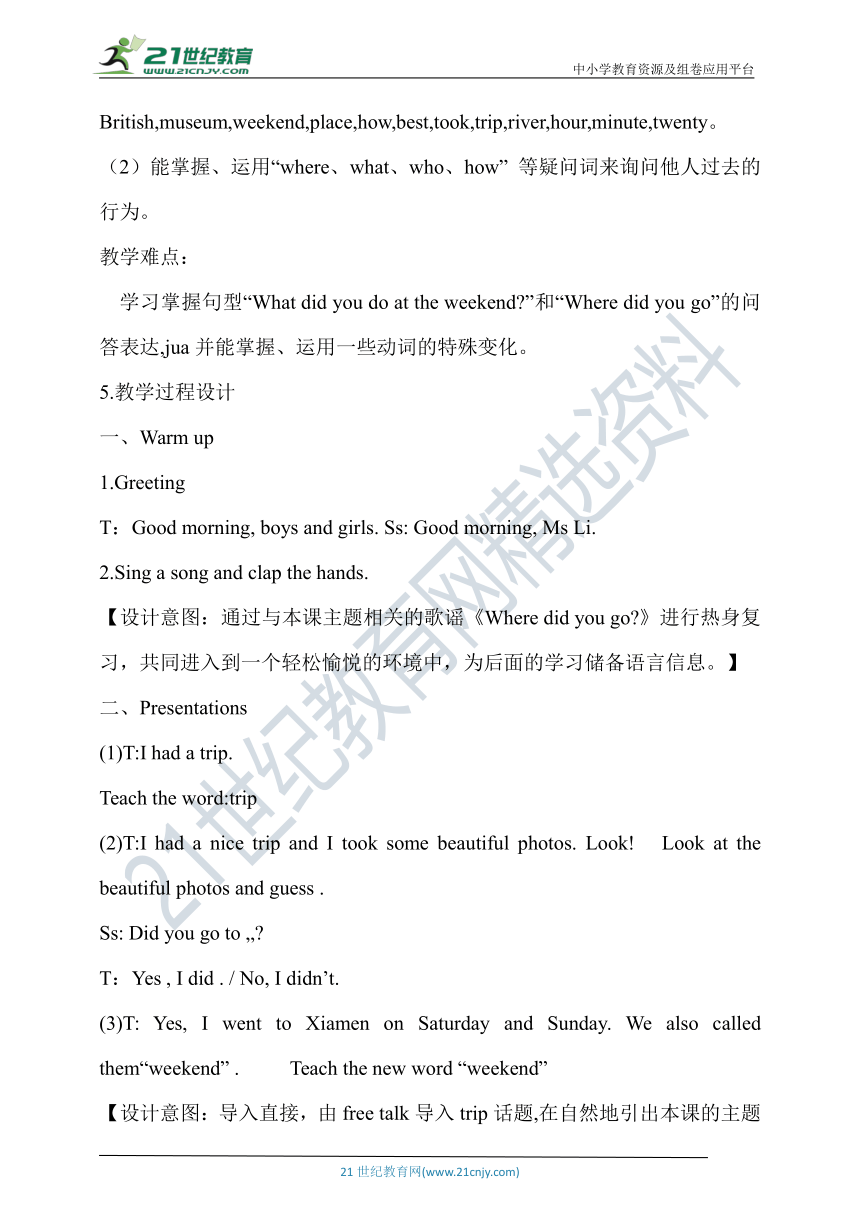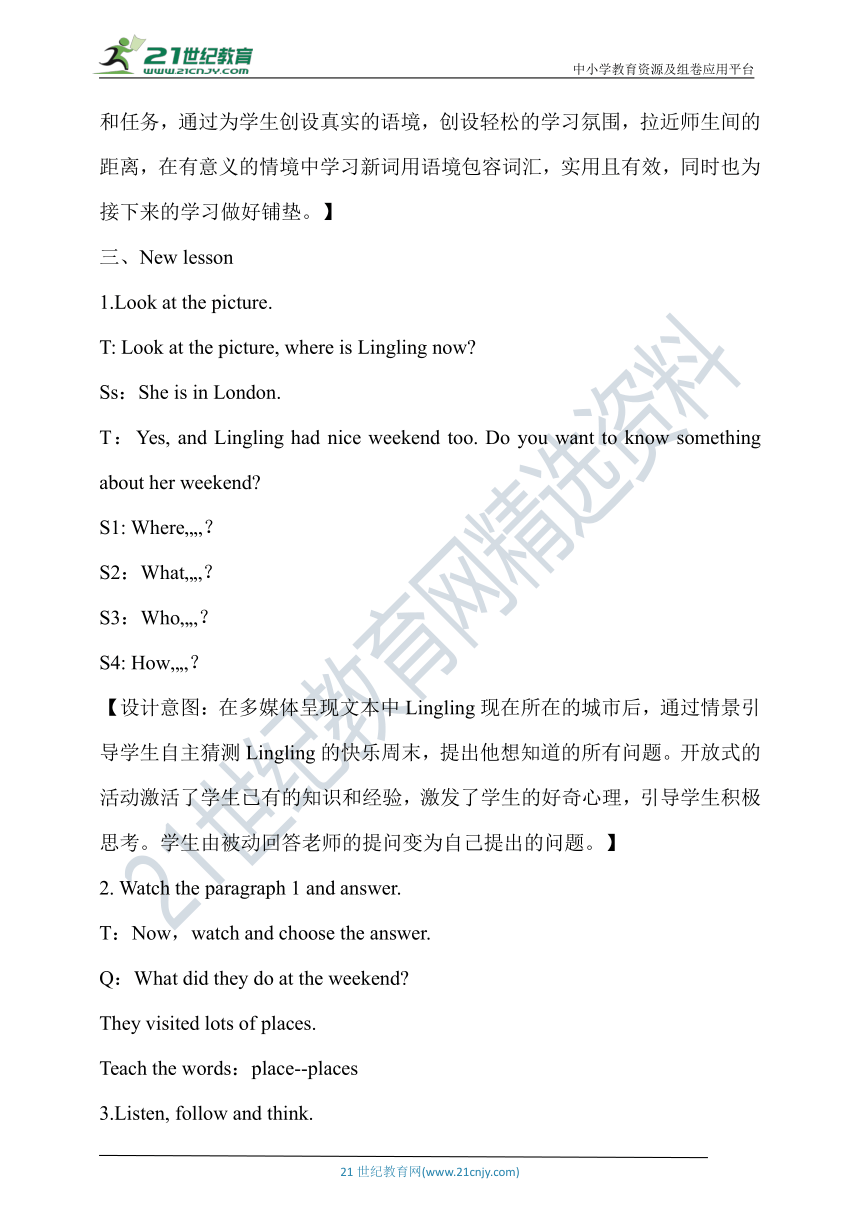Module 3 Unit 1 Where did you go?教案
文档属性
| 名称 | Module 3 Unit 1 Where did you go?教案 |  | |
| 格式 | zip | ||
| 文件大小 | 1.2MB | ||
| 资源类型 | 试卷 | ||
| 版本资源 | 外研版(三年级起点) | ||
| 科目 | 英语 | ||
| 更新时间 | 2020-08-26 09:47:49 | ||
图片预览




文档简介
中小学教育资源及组卷应用平台
外研社起英语五年级上册
Module
3
Unit
1
Where
did
you
go?
教学目标:
1.语言知识目标:
(1)学习单词
British,museum,weekend,place,how,best,took,trip,river,hour,minute,twenty.
(2)用一般过去时表达过去发生的事情
What
did
you
do
at
the
weekend
?
We
visited
lots
of
places.
Where
did
you
go?
We
went
to
the
British
Museum.
2.语言技能目标:
(1)Learn
to
use
the
general
past
tense
to
express
what
happened
in
the
past,
especially
the
past
tense
of
some
irregular
verbs学会运用一般过去时表达过去发生的事情,尤其要掌握部分不规则动词的过去式。
(2)
All
students
can
understand
the
text
with
pictures全体学生能借助图片理解课文内容。
(3)
Develop
students'
ability
to
listen,
speak,
read,
write
and
use
language
flexibly
through
learning,
and
cultivate
students'
awareness
of
competition
and
participation
in
cooperation通过学习培养学生听、说、读、写和灵活运用语言的能力,培养学生的竞争和参与合作的意识。
3.情感态度目标:
(1)In
the
activities
to
cultivate
students
mutual
cooperation,
experience
sharing
learning
spirit在活动中培养学生的互助合作,经验共享的学习精神。
(2)
By
learning
the
past
tense
of
verbs,
we
can
train
students
to
speak
English,
and
let
students
understand
the
value
of
time
and
learn
to
arrange
their
rest
time
reasonably通过学习动词的过去式,培养学生敢于开口说英语,并让学生明白时间的可贵,学会合理安排自己的作息时间。
4、学习策略目标:
(1)
Develop
students'
ability
to
capture
information
and
learn
new
words
and
phrases
using
scenic
spots,
word
cards,
text
context
settings培养学生捕捉信息的能力,利用景点资料、单词卡片、课文语境设置情景学习新单词和短语。
(2)
Using
motivational
evaluation
to
stimulate
students'
desire
for
knowledge
and
expression
in
teaching
activities,
and
to
cultivate
students'
ability
to
use
language
independently
through
group
cooperative
learning采用激励性评价,在教学活动中充分激发学生的求知欲和表现欲,通过小组合作学习,培养学生自主运用语言的能力。
(3)Take
the
initiative
to
ask
teachers
and
classmates
for
advice
on
problems
encountered
in
learning在学习中遇到问题主动向老师和同学请教。
5.文化意识目标:
在学习和日常交际中进一步注意到中外文化的异同。了解不同国家的名胜,自然风光,感受世界风情,了解不同国家的名胜,适当了解一些旅游小知识,并进一步认识中英文在谈论过去和现在事情的异同。
4.教学重点、难点分析
教学重点:
(1)能够听说读写新单词
British,museum,weekend,place,how,best,took,trip,river,hour,minute,twenty。
(2)能掌握、运用“where、what、who、how”
等疑问词来询问他人过去的行为。
教学难点:
学习掌握句型“What
did
you
do
at
the
weekend?”和“Where
did
you
go”的问答表达,jua并能掌握、运用一些动词的特殊变化。
5.教学过程设计
一、Warm
up
1.Greeting
T:Good
morning,
boys
and
girls.
Ss:
Good
morning,
Ms
Li.
2.Sing
a
song
and
clap
the
hands.
【设计意图:通过与本课主题相关的歌谣《Where
did
you
go?》进行热身复习,共同进入到一个轻松愉悦的环境中,为后面的学习储备语言信息。】
二、Presentations
(1)T:I
had
a
trip.
Teach
the
word:trip
(2)T:I
had
a
nice
trip
and
I
took
some
beautiful
photos.
Look!
Look
at
the
beautiful
photos
and
guess
.
Ss:
Did
you
go
to
??
T:Yes
,
I
did
.
/
No,
I
didn’t.
(3)T:
Yes,
I
went
to
Xiamen
on
Saturday
and
Sunday.
We
also
called
them“weekend”
.
Teach
the
new
word
“weekend”
【设计意图:导入直接,由free
talk导入trip话题,在自然地引出本课的主题和任务,通过为学生创设真实的语境,创设轻松的学习氛围,拉近师生间的距离,在有意义的情境中学习新词用语境包容词汇,实用且有效,同时也为接下来的学习做好铺垫。】
三、New
lesson
1.Look
at
the
picture.
T:
Look
at
the
picture,
where
is
Lingling
now?
Ss:She
is
in
London.
T:Yes,
and
Lingling
had
nice
weekend
too.
Do
you
want
to
know
something
about
her
weekend?
S1:
Where???
S2:What???
S3:Who???
S4:
How???
【设计意图:在多媒体呈现文本中Lingling现在所在的城市后,通过情景引导学生自主猜测Lingling的快乐周末,提出他想知道的所有问题。开放式的活动激活了学生已有的知识和经验,激发了学生的好奇心理,引导学生积极思考。学生由被动回答老师的提问变为自己提出的问题。】
2.
Watch
the
paragraph
1
and
answer.
T:Now,watch
and
choose
the
answer.
Q:What
did
they
do
at
the
weekend?
They
visited
lots
of
places.
Teach
the
words:place--places
3.Listen,
follow
and
think.
(1).T:
What
are
these
places?
Ss:
They
went
to
the
British
Museum
and
visited
the
Big
Ben
and
the
London
Eye.
Teach
“the
British
Museum”
(2).Introduce
the
British
Museum.
(3).T:And
how
did
they
do?
Ss:They
went
by
bus.
T:
Did
Lingling
like
the
bus
ride?
Ss:
Yes,
she
did.
T:She
liked
the
bus
ride
best.
Teach
“best”
【设计意图:教师让学生带着他们提出的问题看动画,通过上下文和图片猜词等阅读技巧的指导,让学生学会把握文章的关键词,有助于学生在短时间内确定文章谈论的人物,推测出文章大意。】
4.Read
,point
and
think
(1)Q:What
did
they
take?
Ss:
They
took
a
boat
trip
along
the
river.
Teach:“along
the
river”
(2)T:
How
long?
Ss:
It
took
them
one
hour
and
twenty
minutes.
Teach:“hour
、twenty、minute”
【设计意图:每个新单词的呈现和操练都融入在听音练习中。每个单词的操练教师也给了一定的语用机会,学生觉得说话有意义,所以就有了资源、自主的说话空间,一些发音难点迎刃而解。】
5.Read
the
new
words
quickly.
6.Read
the
dialogue
by
themselves.
7.Look
at
the
blackboard
and
retell
Lingling’s
weekend.
8.Role
play.
【设计意图:通过设计开放性的问题,利用思维导图引导学生讲述本课重点内容,发挥学生思维的能动性,充分给予学生说话的机会,使阅读教学更加突出学生学习的自主性。】
四、Practice
1.Look
at
my
photo.
(1)T:This
is
my
photo.
I
went
to
Xiamen
at
the
weekend.
Do
want
to
know
more?
S1:??
S2:??
S3:??
(2)Talk
about
your
partner’s
photo.
(3)Show
time.
Ask
one
student
to
show
his
photo,the
others
ask
some
questions
about
his
trip.
【设计意图:谈论旅行的照片,引领学生用自己的知识去思考、去交流,让学生在小组活动学习、探索、提高,给学生留下发挥无限智慧和创造力的空间,学生的语言输出更加丰富、自然,学生的思维更加活跃。】
2.Writing
time
(1)Write
about
the
summer
holiday.
(2)Show
time.
【设计意图:通过展示,师生评价,将知识联系到实际生活中,让学生在真实语境下运用语言,从听说读写等方面进行真实地交流运用,从而达到语言习得的目的,让学生体验学习的快乐。】
五、Summary&Assignment
1.Summary
T:Today
we
have
learned?.
总结交流中,不同层次的学生各自回顾了本课学会的单词,以及重点句型,交流各自的收获。
【设计意图:学生通过总结,提炼本课所学。学生在头脑中完整地构建起了知识的框架,为后续学习打下了基础。】
2.Assignment
1.Read
the
dialogue..
2.Finish
the
activities
book。
3.Share
your
holiday
with
more
friends.
【设计意图:作业的设计进一步巩固了重点知识,学生能和父母或更多朋友分享所学,符合小学英语教学所倡导的“听说领先,读写跟上”的原则,有助于巩固拓展深化所学知识。】
Design
for
writing
on
the
blackboard
Module
3
unit1
Where
did
you
go?.
21世纪教育网
www.21cnjy.com
精品试卷·第
2
页
(共
2
页)
HYPERLINK
"http://21世纪教育网(www.21cnjy.com)
"
21世纪教育网(www.21cnjy.com)
外研社起英语五年级上册
Module
3
Unit
1
Where
did
you
go?
教学目标:
1.语言知识目标:
(1)学习单词
British,museum,weekend,place,how,best,took,trip,river,hour,minute,twenty.
(2)用一般过去时表达过去发生的事情
What
did
you
do
at
the
weekend
?
We
visited
lots
of
places.
Where
did
you
go?
We
went
to
the
British
Museum.
2.语言技能目标:
(1)Learn
to
use
the
general
past
tense
to
express
what
happened
in
the
past,
especially
the
past
tense
of
some
irregular
verbs学会运用一般过去时表达过去发生的事情,尤其要掌握部分不规则动词的过去式。
(2)
All
students
can
understand
the
text
with
pictures全体学生能借助图片理解课文内容。
(3)
Develop
students'
ability
to
listen,
speak,
read,
write
and
use
language
flexibly
through
learning,
and
cultivate
students'
awareness
of
competition
and
participation
in
cooperation通过学习培养学生听、说、读、写和灵活运用语言的能力,培养学生的竞争和参与合作的意识。
3.情感态度目标:
(1)In
the
activities
to
cultivate
students
mutual
cooperation,
experience
sharing
learning
spirit在活动中培养学生的互助合作,经验共享的学习精神。
(2)
By
learning
the
past
tense
of
verbs,
we
can
train
students
to
speak
English,
and
let
students
understand
the
value
of
time
and
learn
to
arrange
their
rest
time
reasonably通过学习动词的过去式,培养学生敢于开口说英语,并让学生明白时间的可贵,学会合理安排自己的作息时间。
4、学习策略目标:
(1)
Develop
students'
ability
to
capture
information
and
learn
new
words
and
phrases
using
scenic
spots,
word
cards,
text
context
settings培养学生捕捉信息的能力,利用景点资料、单词卡片、课文语境设置情景学习新单词和短语。
(2)
Using
motivational
evaluation
to
stimulate
students'
desire
for
knowledge
and
expression
in
teaching
activities,
and
to
cultivate
students'
ability
to
use
language
independently
through
group
cooperative
learning采用激励性评价,在教学活动中充分激发学生的求知欲和表现欲,通过小组合作学习,培养学生自主运用语言的能力。
(3)Take
the
initiative
to
ask
teachers
and
classmates
for
advice
on
problems
encountered
in
learning在学习中遇到问题主动向老师和同学请教。
5.文化意识目标:
在学习和日常交际中进一步注意到中外文化的异同。了解不同国家的名胜,自然风光,感受世界风情,了解不同国家的名胜,适当了解一些旅游小知识,并进一步认识中英文在谈论过去和现在事情的异同。
4.教学重点、难点分析
教学重点:
(1)能够听说读写新单词
British,museum,weekend,place,how,best,took,trip,river,hour,minute,twenty。
(2)能掌握、运用“where、what、who、how”
等疑问词来询问他人过去的行为。
教学难点:
学习掌握句型“What
did
you
do
at
the
weekend?”和“Where
did
you
go”的问答表达,jua并能掌握、运用一些动词的特殊变化。
5.教学过程设计
一、Warm
up
1.Greeting
T:Good
morning,
boys
and
girls.
Ss:
Good
morning,
Ms
Li.
2.Sing
a
song
and
clap
the
hands.
【设计意图:通过与本课主题相关的歌谣《Where
did
you
go?》进行热身复习,共同进入到一个轻松愉悦的环境中,为后面的学习储备语言信息。】
二、Presentations
(1)T:I
had
a
trip.
Teach
the
word:trip
(2)T:I
had
a
nice
trip
and
I
took
some
beautiful
photos.
Look!
Look
at
the
beautiful
photos
and
guess
.
Ss:
Did
you
go
to
??
T:Yes
,
I
did
.
/
No,
I
didn’t.
(3)T:
Yes,
I
went
to
Xiamen
on
Saturday
and
Sunday.
We
also
called
them“weekend”
.
Teach
the
new
word
“weekend”
【设计意图:导入直接,由free
talk导入trip话题,在自然地引出本课的主题和任务,通过为学生创设真实的语境,创设轻松的学习氛围,拉近师生间的距离,在有意义的情境中学习新词用语境包容词汇,实用且有效,同时也为接下来的学习做好铺垫。】
三、New
lesson
1.Look
at
the
picture.
T:
Look
at
the
picture,
where
is
Lingling
now?
Ss:She
is
in
London.
T:Yes,
and
Lingling
had
nice
weekend
too.
Do
you
want
to
know
something
about
her
weekend?
S1:
Where???
S2:What???
S3:Who???
S4:
How???
【设计意图:在多媒体呈现文本中Lingling现在所在的城市后,通过情景引导学生自主猜测Lingling的快乐周末,提出他想知道的所有问题。开放式的活动激活了学生已有的知识和经验,激发了学生的好奇心理,引导学生积极思考。学生由被动回答老师的提问变为自己提出的问题。】
2.
Watch
the
paragraph
1
and
answer.
T:Now,watch
and
choose
the
answer.
Q:What
did
they
do
at
the
weekend?
They
visited
lots
of
places.
Teach
the
words:place--places
3.Listen,
follow
and
think.
(1).T:
What
are
these
places?
Ss:
They
went
to
the
British
Museum
and
visited
the
Big
Ben
and
the
London
Eye.
Teach
“the
British
Museum”
(2).Introduce
the
British
Museum.
(3).T:And
how
did
they
do?
Ss:They
went
by
bus.
T:
Did
Lingling
like
the
bus
ride?
Ss:
Yes,
she
did.
T:She
liked
the
bus
ride
best.
Teach
“best”
【设计意图:教师让学生带着他们提出的问题看动画,通过上下文和图片猜词等阅读技巧的指导,让学生学会把握文章的关键词,有助于学生在短时间内确定文章谈论的人物,推测出文章大意。】
4.Read
,point
and
think
(1)Q:What
did
they
take?
Ss:
They
took
a
boat
trip
along
the
river.
Teach:“along
the
river”
(2)T:
How
long?
Ss:
It
took
them
one
hour
and
twenty
minutes.
Teach:“hour
、twenty、minute”
【设计意图:每个新单词的呈现和操练都融入在听音练习中。每个单词的操练教师也给了一定的语用机会,学生觉得说话有意义,所以就有了资源、自主的说话空间,一些发音难点迎刃而解。】
5.Read
the
new
words
quickly.
6.Read
the
dialogue
by
themselves.
7.Look
at
the
blackboard
and
retell
Lingling’s
weekend.
8.Role
play.
【设计意图:通过设计开放性的问题,利用思维导图引导学生讲述本课重点内容,发挥学生思维的能动性,充分给予学生说话的机会,使阅读教学更加突出学生学习的自主性。】
四、Practice
1.Look
at
my
photo.
(1)T:This
is
my
photo.
I
went
to
Xiamen
at
the
weekend.
Do
want
to
know
more?
S1:??
S2:??
S3:??
(2)Talk
about
your
partner’s
photo.
(3)Show
time.
Ask
one
student
to
show
his
photo,the
others
ask
some
questions
about
his
trip.
【设计意图:谈论旅行的照片,引领学生用自己的知识去思考、去交流,让学生在小组活动学习、探索、提高,给学生留下发挥无限智慧和创造力的空间,学生的语言输出更加丰富、自然,学生的思维更加活跃。】
2.Writing
time
(1)Write
about
the
summer
holiday.
(2)Show
time.
【设计意图:通过展示,师生评价,将知识联系到实际生活中,让学生在真实语境下运用语言,从听说读写等方面进行真实地交流运用,从而达到语言习得的目的,让学生体验学习的快乐。】
五、Summary&Assignment
1.Summary
T:Today
we
have
learned?.
总结交流中,不同层次的学生各自回顾了本课学会的单词,以及重点句型,交流各自的收获。
【设计意图:学生通过总结,提炼本课所学。学生在头脑中完整地构建起了知识的框架,为后续学习打下了基础。】
2.Assignment
1.Read
the
dialogue..
2.Finish
the
activities
book。
3.Share
your
holiday
with
more
friends.
【设计意图:作业的设计进一步巩固了重点知识,学生能和父母或更多朋友分享所学,符合小学英语教学所倡导的“听说领先,读写跟上”的原则,有助于巩固拓展深化所学知识。】
Design
for
writing
on
the
blackboard
Module
3
unit1
Where
did
you
go?.
21世纪教育网
www.21cnjy.com
精品试卷·第
2
页
(共
2
页)
HYPERLINK
"http://21世纪教育网(www.21cnjy.com)
"
21世纪教育网(www.21cnjy.com)
同课章节目录
- Module 1
- Unit 1 Did you come back yesterday?
- Unit 2 We bought ice creams.
- Module 2
- Unit 1 What did you buy?
- Unit 2 How much cheese did you buy?
- Module 3
- Unit 1 Where did you go?
- Unit 2 Daming took a photo of his father.
- Module 4
- Unit 1 Mum bought a new T-shirt for me.
- Unit 2 What's the matter with Daming?
- Module 5
- Unit 1 There are only nineteen crayons
- Unit 2 There are forty.
- Module 6
- Unit 1 You can play football well.
- Unit 2 He ran very fast.
- Module 7
- Unit 1 He can't see.
- Unit 2 This little girl can't walk.
- Module 8
- Unit 1 What time does your school start?
- Unit 2 Yesterday I went to Sam and Amy's school.
- Module 9
- Unit 1 Are you feeling bored?
- Unit 2 I feel happy.
- Review Module
- Unit 1
- Unit 2
- Module 10
- Unit 1 He was in the kitchen.
- Unit 2 Don't shout, please!
- 旧版资料
- Module 1 London
- Module 2 Shopping
- Module 3 At the Weekend
- Module 4 Possession
- Module 5 In Class
- Module 6 Self-assessment
- Module 7 Community
- Module 8 School
- Module 9 Feelings
- Module 10 Manners
- Review Module
